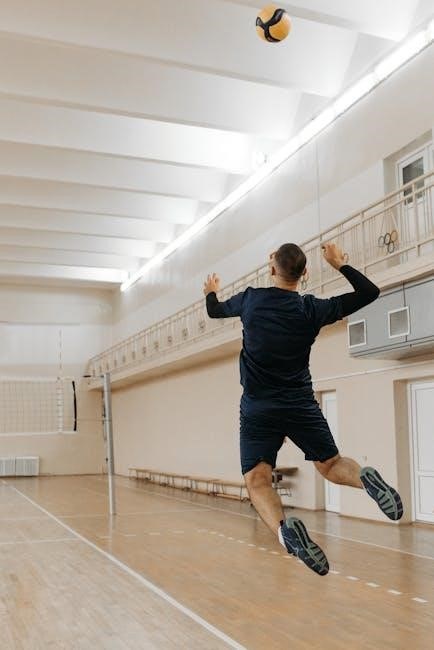
volleyball 6-2 rotation pdf
The volleyball 6-2 rotation pdf provides details on offense strategy, with two setters and four hitters, creating a strong attacking team, using
specific formations
and player positions effectively always.
Understanding the Fundamentals
The volleyball 6-2 rotation pdf is based on a system that utilizes two setters and four hitters, creating a strong attacking team.
This formation is often used in competitive volleyball, as it allows for a balanced offense and defense.
The 6-2 rotation is a fundamental concept in volleyball, and understanding its basics is crucial for players and coaches.
The rotation is designed to optimize the team’s attacking and defensive capabilities, by positioning players in specific locations on the court.
The volleyball 6-2 rotation pdf provides a detailed explanation of the formation, including the roles of each player and the strategic advantages of this system;
It is essential to understand the fundamentals of the 6-2 rotation to implement it effectively in a game.
The pdf document is a valuable resource for those looking to improve their knowledge of volleyball strategies and tactics.
By studying the 6-2 rotation, players and coaches can gain a deeper understanding of the game and develop effective winning strategies.
The fundamentals of the 6-2 rotation are the building blocks of a successful volleyball team.

Volleyball Court Positions and Rotations
Players rotate in a clockwise direction, using
standard positions
and formations to outmaneuver opponents effectively always.
Standard Positions and Names
The volleyball court is divided into six positions, each with a specific name and number, including right back, right front, and center front, denoted as P1 to P6, which are used to identify player positions and rotations, and are essential for understanding the 6-2 rotation system, where players move in a clockwise direction, and must be aware of their position and the positions of their teammates at all times, in order to execute the play effectively, and the standard positions and names are used to facilitate communication and coordination among players, and to ensure that each player knows their role and responsibility within the team, and the standard positions are also used to identify the different rotations and formations that can be used during a game, and to analyze the strengths and weaknesses of each position and rotation.

Offensive Rotations
Offensive rotations include various systems, using
different formations
and strategies to outmaneuver opponents effectively always.
Common Rotations 5-1, 6-2, and 4-2
The volleyball 6-2 rotation pdf discusses common rotations, including 5-1, 6-2, and 4-2 systems, each with its own strengths and weaknesses, and optimal player positions and movements.
These rotations are used to create a strong offense, with the 5-1 rotation using one setter and five hitters, the 6-2 rotation using two setters and four hitters, and the 4-2 rotation using two setters and four hitters.
Each rotation has its own unique characteristics, and teams must choose the one that best fits their players’ skills and abilities, and be able to adapt to different game situations and opponents.
The 6-2 rotation is particularly effective, as it allows for two setters to be on the court at the same time, creating a strong attacking team, and the ability to switch between different formations and strategies.
Serve-Receive Rotations
Volleyball teams use rotations to optimize serve-receive formations and strategies always effectively.
Diagrams of Serve-Receive Rotations
Diagrams of serve-receive rotations are essential for understanding volleyball strategies, including the 6-2 rotation. These diagrams illustrate the positions of players on the court, including setters, hitters, and blockers. By analyzing these diagrams, teams can optimize their serve-receive formations and improve their overall performance. The diagrams typically show the rotation of players, including the movement of setters and hitters, and the positioning of blockers. They also provide information on the serving and receiving strategies, including the types of serves and the receiving formations. With the help of these diagrams, teams can develop effective serve-receive rotations and improve their chances of winning. The diagrams are usually available in volleyball 6-2 rotation pdf files, which provide a comprehensive guide to the strategy and its implementation. Teams can use these diagrams to practice and refine their serve-receive rotations, leading to improved performance and success.

6-2 Rotation Guide
The guide provides detailed information on volleyball rotations, formations, and strategies, using
specific terms
and player positions always effectively online.
Sample Rotations and Positions
The volleyball 6-2 rotation pdf includes sample rotations and positions, demonstrating how players move around the court, with two setters and four hitters, creating a strong attacking team.
The formations show the positions of the players, including the setter, hitters, and blockers, and how they work together to achieve a strong offense.
The guide provides detailed information on the rotations, including the positions of the players, and how they move around the court.
The sample rotations and positions are an essential part of the guide, as they provide a visual representation of the volleyball 6-2 rotation, making it easier for players and coaches to understand and implement the strategy.
The rotations and positions are designed to create a strong and effective offense, with the two setters and four hitters working together to outmaneuver the opposing team.
The sample rotations and positions are a key component of the volleyball 6-2 rotation pdf, providing a comprehensive understanding of the strategy and its implementation.

Base Position and Movement
Players move into base position quickly, using
specific movements
to get into place, always.
Importance of Base Position in 6-2 Offense
The base position is crucial in a 6-2 offense, as it allows players to move efficiently and effectively around the court, using a combination of movements and formations to outmaneuver their opponents.
The ability to get into base position quickly is essential, as it enables players to be in the right place at the right time, making it easier to execute plays and score points.
A well-executed base position can make a significant difference in the outcome of a game, as it can create scoring opportunities and put pressure on the opposing team’s defense.
By understanding the importance of base position, teams can improve their overall performance and increase their chances of winning, which is a key aspect of the volleyball 6-2 rotation pdf strategy.
This strategy is used by many teams to gain a competitive edge and achieve success in the sport.
The volleyball 6-2 rotation pdf concludes with effective strategies always.
The volleyball 6-2 rotation pdf provides a comprehensive overview of the offense strategy, including player positions and formations. The 6-2 rotation is a popular choice among teams, as it allows for two setters to be on the court at the same time, creating a strong attacking team. The pdf document discusses the benefits of the 6-2 rotation, including increased scoring opportunities and improved teamwork. It also outlines the different player positions, including the setters, hitters, and blockers, and how they work together to execute the offense. Additionally, the pdf provides diagrams and illustrations to help coaches and players understand the rotation and how to implement it effectively. Overall, the volleyball 6-2 rotation pdf is a valuable resource for anyone looking to improve their team’s offense and gain a competitive edge. With its clear explanations and detailed diagrams, it is an essential tool for coaches and players alike.